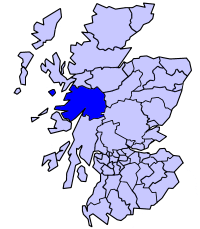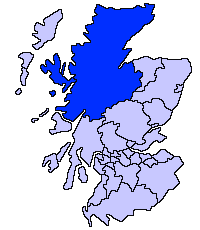Lochaber


Lochaber (/lɒxˈɑːbər/) (Scottish Gaelic: Loch Abar) is an area in the west of the Scottish Highlands. Historically it referred to the area between Loch Linnhe and Loch Leven, around the town of Fort William. It is now also used to refer to a much wider area, one of the 16 ward management areas of the Highland Council of Scotland and one of eight former local government districts of the two-tier Highland region.
The ward management area is one of five comprising the Highland Council's Ross, Skye and Lochaber corporate management area, which is one of three Highland Council corporate management areas. The Ross, Skye and Lochaber area consists of six out of the 22 wards of the council area and the Lochaber area consists of two wards, the Caol and Mallaig ward, which elects three councillors, and the Fort William and Ardnamurchan ward, which elects four councillors.[1] Each of the other wards of the corporate area is a separate ward management area.
There is also a Ross, Skye and Lochaber constituency of the House of Commons of the Parliament of the United Kingdom (at Westminster), but its boundaries are not exactly those of the council corporate management area. The constituency was created in 2005 with boundaries based on those of wards in use during the period 1999 to 2007.
According to legend a glaistig, an evil woman-goat hybrid, once lived in the area.[2]
History of local government
As statutory local government areas, the Highland region and its districts were created in 1975, under the Local Government (Scotland) Act 1973, and abolished in 1996. The 1973 legislation abolished local government counties and burghs throughout Scotland and created a new system of nine two-tier regions and three islands council areas. Each region consisted of a number of districts and the islands areas were created as unitary council areas.
The Lochaber district of the Highland region was created by merging the Ardnamurchan district and the Ballachulish and Kinlochleven electoral divisions of the former county of Argyll with the burgh of Fort William and the district of Lochaber of the former county of Inverness. Therefore, the boundaries of the district included North Lorne, Glen Coe, Nether Lochaber, the western part of the Rannoch Moor, the Road to the Isles, Moidart, Ardgour, Morvern, Sunart, Ardnamurchan, and the Small Isles (Rùm, Eigg, Muck and Canna).
The 1994 legislation abolished regions and districts and established a system of 32 unitary council areas covering the whole of Scotland, and all of the Highland districts were merged into the new unitary Highland council area.
In 1996 the new Highland Council adopted the areas of the former districts as council management areas, and created area committees to represent them. The Lochaber management area then consisted of eight out of the 72 wards of the council area, each electing one councillor by the first past the post system of election. In 1999 ward boundaries were redrawn to create 80 new wards. Management area boundaries were not redrawn, however, and therefore area committees ceased to represent exactly the areas for which they were named and made decisions. The Lochaber committee continued to have eight members. The area manager throughout this period (1996–2007) was John Hutchison.
Ward boundaries were redrawn again in 2007 under the Local Governance (Scotland) Act 2004, and the council abolished its eight management areas in favour of three new corporate management areas and 16 new ward management areas. Each of the 22 new wards elects three or four councillors by the single transferable vote system, a system designed to produce a form of proportional representation, and the total number of councillors remains the same. Various ward management areas, including the Lochaber area, cover more than one ward.

Columba
Lochaber is mentioned by Adomnan of Iona in his biography of St Columba on two occasions. Both stories related to Columba using his saintly blessing to raise people out of poverty and make them wealthier.
In the first story, Columba met a poor man named Nesán in Lochaber who had five cows. Columba blessed the poor man's cows and his own descendants, and the poor man's five cows multiplied until he had a herd of one hundred and five cows.[3]
In the second story, Columba met a beggar in Lochaber who had a wife and children. Columba asked the beggar to fetch him a stick from the forest, and the poor man did so. Columba then sharpened the stick into a stake and gave it to the man, telling him that it would catch game for him, but it would never harm person or cattle. The poor man then took the stake and put it into the forest, and the following day he checked it and found a stag had gotten impaled on it. And every day that passed by some new animal fell on it and got killed on it. The poor man sold the meat and skins to others and got much profit out of it. However, his wife urged him to get rid of it, because she thought it was too dangerous. The man reluctantly listened to his wife and put the stake next to the wall of his house. But one day, a dog fell on it and got killed. His wife then urged him to get rid of it because it was so dangerous, and the man then put the stake into thick brambles, but the following day he found a goat had somehow impaled itself on the stake through the brambles. He then took the stake to the river Lochy and put it underwater, and returning later he saw a large salmon had gotten impaled on it. He then took the stake and set it on the roof of his house, but not long afterwards, a large raven flew by and got impaled on it. The man's wife continued to nag him about how dangerous it was, and so he cut up the stake into pieces and destroyed it. Afterwards he returned to begging again.[3]
Hydroelectric scheme
See also
References
Further reading
- Howat, Patrick, The Lochaber Narrow Gauge Railway, Northern Books from Famedram, ISBN 0-905489-43-8, now out of print
Coordinates: 56°48′25″N 5°37′50″W / 56.80689°N 5.63046°W